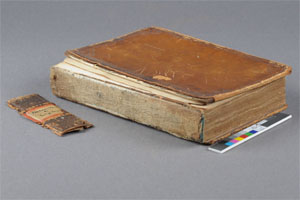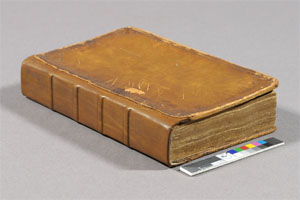Rebacking a Damaged Spine
Ranulf de Glanville, Tractatus de legibus & consuetudinibus regni Angliae, tempore Regis Henrici Secundi compositus: iusticiae gubernacula tenente illustri viro Ranulpho de Glanvilla iuris regni & antiquarum consuetudinum eo tempore peritissimo, [London]: in aedibus Thomae Wight, 1604.

Ranulf de Glanville (died 1190) was chief justiciar of England during the reign of King Henry II. He served in various capacities under Henry II from 1176 until his appointment as Chief Justiciar of England in1180. Glanville is credited with the writing of the Tractatus, which was a practical treatise on the forms of procedure in the curia regis – the king's court, but it is possibly the work of one of his successors. This work greatly extended the scope of the common law at the expense of canon law and local law. The treatise was first printed in 1554. The Tarlton copy is ex libris, bearing the library stamp of the American Congregational Association in Boston, Massachusetts.
Brief Summary of Conservation Treatment
Conserved by: Katherine Lechuga Length of Treatment: 8 Hours 
The book is bound in a full light brown calf binding with blind tooled filets and abstract floral motifs on the boards and the spine. The leather covers an earlier paper binding.
The front and back covers were completely detached. The leather was in fair condition, showing some abrasion, darkening and minor cracking. The spine was completely detached. Inside, the front fly leaves were completely detached. The sewing was sufficiently intact to hold all the sections together. The textblock was in fair condition, slightly dusty with some scattered areas of minor tan staining. The outside of edges of the textblock had darkened become brittle.
The first step was lifting the original boards along the spine edge. After custom dying repair calf leather to match the original leather, Ms. Lechuga cleaned the spine to remove as much original animal hide glue as possible. The spine was then relined, and a new hollow tube constructed. Following the creation of false raised bands, she then re-backed the book with the custom dyed letter and pasted down the lifted edges of the original boards. After reinforcing the joints and touching up the leather, Ms. Lechuga blind tooled lines along the raised bands to mimic the original spine.
For more information see the full Conservation Treatment Report


